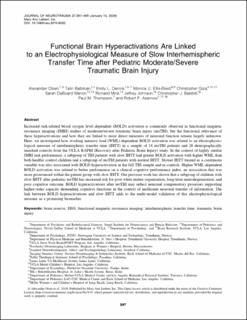| dc.contributor.author | Olsen, Alexander | |
| dc.contributor.author | Babikian, Talin | |
| dc.contributor.author | Dennis, Emily L. | |
| dc.contributor.author | Ellis-Blied, Monica U. | |
| dc.contributor.author | Giza, Christopher C. | |
| dc.contributor.author | Marion, Sarah DeBoard | |
| dc.contributor.author | Mink, Richard | |
| dc.contributor.author | Johnson, Jeffrey | |
| dc.contributor.author | Babbitt, Christopher | |
| dc.contributor.author | Thompson, Paul M. | |
| dc.contributor.author | Asarnow, Robert F. | |
| dc.date.accessioned | 2021-02-16T08:59:49Z | |
| dc.date.available | 2021-02-16T08:59:49Z | |
| dc.date.created | 2020-10-26T14:34:31Z | |
| dc.date.issued | 2020 | |
| dc.identifier.citation | Journal of Neurotrauma. 2020, 37 (2), 397-409. | en_US |
| dc.identifier.issn | 0897-7151 | |
| dc.identifier.uri | https://hdl.handle.net/11250/2728256 | |
| dc.description.abstract | Increased task-related blood oxygen level dependent (BOLD) activation is commonly observed in functional magnetic resonance imaging (fMRI) studies of moderate/severe traumatic brain injury (msTBI), but the functional relevance of these hyperactivations and how they are linked to more direct measures of neuronal function remain largely unknown. Here, we investigated how working memory load (WML)-dependent BOLD activation was related to an electrophysiological measure of interhemispheric transfer time (IHTT) in a sample of 18 msTBI patients and 26 demographically matched controls from the UCLA RAPBI (Recovery after Pediatric Brain Injury) study. In the context of highly similar fMRI task performance, a subgroup of TBI patients with slow IHTT had greater BOLD activation with higher WML than both healthy control children and a subgroup of msTBI patients with normal IHTT. Slower IHTT treated as a continuous variable was also associated with BOLD hyperactivation in the full TBI sample and in controls. Higher WML-dependent BOLD activation was related to better performance on a clinical cognitive performance index, an association that was more pronounced within the patient group with slow IHTT. Our previous work has shown that a subgroup of children with slow IHTT after pediatric msTBI has increased risk for poor white matter organization, long-term neurodegeneration, and poor cognitive outcome. BOLD hyperactivations after msTBI may reflect neuronal compensatory processes supporting higher-order capacity demanding cognitive functions in the context of inefficient neuronal transfer of information. The link between BOLD hyperactivations and slow IHTT adds to the multi-modal validation of this electrophysiological measure as a promising biomarker. | en_US |
| dc.language.iso | eng | en_US |
| dc.publisher | Mary Ann Liebert Inc. | en_US |
| dc.rights | Navngivelse 4.0 Internasjonal | * |
| dc.rights.uri | http://creativecommons.org/licenses/by/4.0/deed.no | * |
| dc.title | Functional Brain Hyperactivations Are Linked to an Electrophysiological Measure of Slow Interhemispheric Transfer Time after Pediatric Moderate/Severe Traumatic Brain Injury | en_US |
| dc.type | Peer reviewed | en_US |
| dc.type | Journal article | en_US |
| dc.description.version | publishedVersion | en_US |
| dc.source.pagenumber | 397-409 | en_US |
| dc.source.volume | 37 | en_US |
| dc.source.journal | Journal of Neurotrauma | en_US |
| dc.source.issue | 2 | en_US |
| dc.identifier.doi | 10.1089/neu.2019.6532 | |
| dc.identifier.cristin | 1842356 | |
| dc.description.localcode | This Open Access article is distributed under the terms of the Creative Commons License ( http://creativecommons.org/licenses/by/4.0), which permits unrestricted use, distribution, and reproduction in any medium, provided the original work is properly credited. | en_US |
| cristin.ispublished | true | |
| cristin.fulltext | original | |
| cristin.qualitycode | 1 | |

